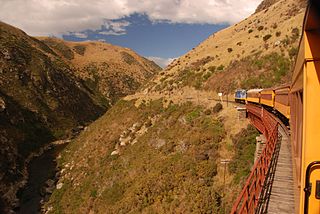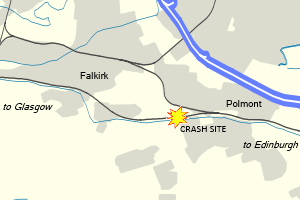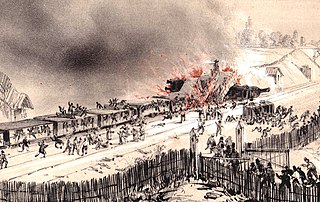
The Granville rail/train disaster occurred on Tuesday 18 January 1977 at Granville, a western suburb of Sydney, New South Wales, Australia, when a crowded commuter train derailed, running into the supports of a road bridge that collapsed onto two of the train's passenger carriages. The official enquiry found the primary cause of the crash to be poor fastening of the track.

The Tangiwai disaster occurred at 10:21 p.m. on 24 December 1953 when a railway bridge over the Whangaehu River collapsed beneath an express passenger train at Tangiwai, North Island, New Zealand. The locomotive and the first six carriages derailed into the river, killing 151 people. The subsequent board of inquiry found that the accident was caused by the collapse of the tephra dam holding back nearby Mount Ruapehu's crater lake, creating a rapid mudflow (lahar) in the Whangaehu River, which destroyed one of the bridge piers at Tangiwai only minutes before the train reached the bridge. The volcano itself was not otherwise erupting at the time. The disaster remains New Zealand's worst rail accident.

Rail transport in New Zealand is an integral part of New Zealand's transport network, with a nationwide network of 4,375.5 km (2,718.8 mi) of track linking most major cities in the North and South Islands, connected by inter-island rail and road ferries. Rail transport in New Zealand has a particular focus on bulk freight exports and imports, with 19 million net tonnes moved by rail annually, with 99.5% of New Zealand's exports and imports being transported through the country's seaports.

Dunedin Railways is the trading name of Dunedin Railways Limited, an operator of a railway line and tourist trains based at Dunedin Railway Station in the South Island of New Zealand. The company is a council-controlled trading organisation wholly owned by Dunedin City Council through its holding company Dunedin City Holdings Limited.

The Ocean Beach Railway (OBR) is a heritage railway that operates in Dunedin, New Zealand. It is located between John Wilson Drive in the suburb of Saint Kilda and sports grounds near Forbury Park Raceway, and runs parallel with the city's main beach, Ocean Beach. This is near where the Ocean Beach Branch once ran, but not on the same formation.
The Southerner was a passenger express train in New Zealand's South Island between Christchurch and Invercargill along the South Island Main Trunk, that ran from 1970 to 2002. It was one of the premier passenger trains in New Zealand and its existence made Invercargill the southernmost passenger station in the world.

The Polmont rail accident, also known as the Polmont rail disaster, occurred on 30 July 1984 to the west of Polmont, near Falkirk, in Scotland. A westbound push-pull express train travelling from Edinburgh to Glasgow struck a cow, which had gained access to the track through a damaged fence from a field near Polmont railway station. The collision caused all six carriages and the locomotive of the train to derail, killing 13 people and injuring 61 others. The accident led to a debate about the safety of push-pull trains on British Rail.

The Staplehurst rail crash was a derailment at Staplehurst, Kent, on 9 June 1865 at 3:13 pm. The South Eastern Railway Folkestone to London boat train derailed while crossing a viaduct where a length of track had been removed during engineering works, killing ten passengers and injuring forty. In the Board of Trade report it was found that a man had been placed with a red flag 554 yards (507 m) away but the regulations required him to be 1,000 yards (910 m) away and the train had insufficient time to stop.
The Valigonda rail disaster occurred on 29 October 2005 near the town of Valigonda, south of Hyderabad in the Indian state of Andhra Pradesh. A flash flood swept away a small rail bridge, and a "Delta Fast Passenger" train traveling on it derailed at the broken section of the line, killing at least 114 people and injuring over 200.

The Otago Central Railway (OCR) or in later years Otago Central Branch Railway, now often referred to as the Taieri Gorge Railway, was a secondary railway line in Central Otago, in the South Island of New Zealand.

Hyde is a locality in Otago, New Zealand, located in the Strath-Taieri. It is close to the northern end of the Rock and Pillar Range on State Highway 87 between Middlemarch and Ranfurly. Hyde is best known as the site of the Hyde railway disaster of 4 June 1943, in which 21 people were killed when an express train on the Otago Central Railway derailed at high speed in a cutting near the town. At the time, it was the worst railway accident in New Zealand's history; it has only been passed by the Tangiwai disaster of 24 December 1953, which claimed the lives of 151 people. The site of the Hyde disaster can now be walked as part of the Otago Central Rail Trail and a monument, a 2.5 m high cairn, stands as a memorial to the victims.
There have been a number of train accidents on the railway network of Victoria, Australia. Some of these are listed below.

On 8 May 1842, a train crashed in the cutting between Meudon and Bellevue stations on the railway between Versailles and Paris, France. The train was travelling to Paris when it derailed after the leading locomotive broke an axle, and the carriages behind piled into it and caught fire. It was the first French railway accident and the deadliest in the world at the time, causing between 52 and 200 deaths, including that of explorer Jules Dumont d'Urville. The accident led the French to abandon the practice of locking passengers in their carriages.

Great Western Railway accidents include several notable incidents that influenced rail safety in the United Kingdom.

The Rakaia railway accident at Rakaia, Canterbury, New Zealand on the evening of Saturday, 11 March 1899 occurred when the second of two excursion trains returning from Ashburton to Christchurch ran into the rear of the first at the Rakaia Railway Station, killing four passengers. While due to excessive speed, the accident resulted in overdue improvements by New Zealand Railways to signalling and braking.
The Rimutaka incline railway line suffered from strong cross winds. On two occasions passenger trains were derailed by them. The first in 1880 resulting in four deaths, and the second in 1936 resulting in only injuries.

The Ongarue railway disaster occurred on 6 July 1923 near the small settlement of Ongarue, near Taumarunui, North Island, New Zealand, when an overnight express ran into a landslip. Of the 200 passengers on board, 17 died and 28 were injured. The disaster marked the first major loss of life in New Zealand railway history; the Christchurch Press noted that each of the previous fatal railway accidents had resulted in no greater loss of life than that resulting from an overturned motor car.













